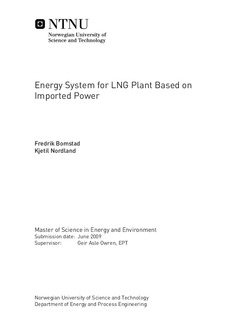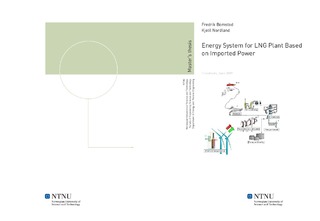| dc.description.abstract | It has been proposed to supply heat and power to Snøhvit Train II (STII) from onsite heat generation based on natural gas and power import from the power grid. Without carbon capture and storage, greenhouse gas (GHG) emissions from the combustion of natural gas in furnaces make a considerable contribution to the global warming potential (GWP) of this energy system. Depending on the interpretation of marginal power consumption, the power import also contributes to and increases this system s GWP. A recent SINTEF report claimed that European CO2 emissions are reduced with additional renewable power production in Norway, and it has been suggested to invest in wind power in order to completely offset the GWP of the STII energy system. This paper provides investment analyses for the proposed energy system. A scenario approach was used, with six different scenarios covering two dimensions. The first dimension is the origin of the grid power, with three different interpretations of marginal power representing Cases A, B and C. The other dimension is the STII train size, with two different sizes being analyzed, namely 50 % and 70 % of the Snøhvit Train I design capacity. The proposed energy system was also analyzed with respect to security of supply. Improved reliability and transmission capacity, together with a stable, positive power balance, make a good foundation for security of power supply. The power demand of the two train sizes was estimated to 101 MW and 141 MW, with corresponding heat demand of 94 MW and 131 MW. These estimates were based on a combination of HYSYS simulations and data provided by StatoilHydro (SH), and provided input for both the GWP analysis and the investment analysis. The GWP impact of each scenario determined the share of power import from the grid that would have to be replaced by energy harnessed from wind. The applied capacity factor was 39.6 %, and the rated wind power requirement for the six different scenarios ranged from 101 MW for the A.50 scenario to 257 MW for the C.70 scenario. The break even (BE) energy prices were calculated for each of the six scenarios analyzed. If the power consumption is based solely on power import, with zero StatoilHydro (SH) share of grid reinforcements and no SH development of wind power, the BE power price would be 466 NOK/MWh. The inclusion of wind power development as part of the investment will increase the BE power price by up to 33 NOK/MWh. The additional SH share of grid reinforcement will add 86 NOK/MWh for the 50 % STII or 62 NOK/MWh for the 70 % STII. It was shown that the investment in wind power to offset the GWP of the energy system might also be a reasonable way of hedging against increases in the market price of electricity. It was found that the share of STII power demand that is provided by wind power is one of the parameters that have the least influence on the project s net present value (NPV). A high share of wind power is an inexpensive investment in improving reputation and predictability of energy price. | nb_NO |

